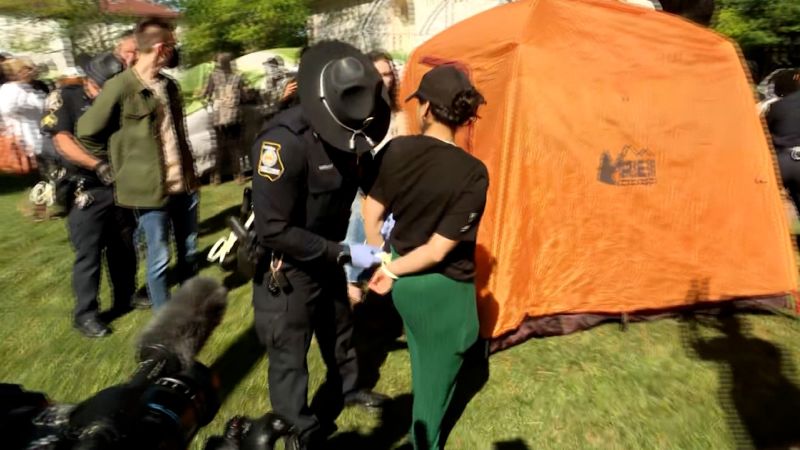U.S. employers added an astonishing 528,000 jobs last month despite flashing warning signs of an economic downturn, easing fears of a recession and handing President Joe Biden some good news heading into the midterm elections.
Unemployment dropped another notch, from 3.6% to 3.5%, matching the more than 50-year low reached just before the pandemic took hold.
:quality(70)/cloudfront-us-east-1.images.arcpublishing.com/tronc/BFUD5DUG6JH3FFZPKP2OH7YULE.jpg)
The economy has now recovered all 22 million jobs lost in March and April 2020 when COVID-19 slammed the U.S.
The red-hot numbers reported Friday by the Labor Department are certain to intensify the debate over whether the U.S. is in a recession.
“Recession — what recession?’’ wrote Brian Coulton, chief economist at Fitch Ratings. “The U.S. economy is creating new jobs at an annual rate of 6 million — that’s three times faster than what we normally see historically in a good year.”
:quality(70)/cloudfront-us-east-1.images.arcpublishing.com/tronc/NOA7FUIN25H37MY57VC75K5IPU.jpg)
Economists had expected only 250,000 new jobs last month, in a drop-off from June’s revised 398,000. Instead, July proved to be the best month since February.
The strong figures are welcome news for the Biden administration and the Democrats at a time when many voters are worried about the economy.
Inflation is raging at its highest level in more than 40 years, and the economy has contracted for two quarters in a row, which is the common — but informal — definition of a recession and does not take into account a host of other factors economists consider, such as the job picture.
:quality(70)/cloudfront-us-east-1.images.arcpublishing.com/tronc/CXAF2NSI6BCDDFJP4T5X57D2ZM.jpg)
At the White House, Biden credited the job growth to his policies, even as he acknowledged the pain being inflicted by inflation. He emphasized the addition of 642,000 manufacturing jobs during his watch.
“Instead of workers begging employers for work, we’re seeing employers have to compete for American workers,” the president said.
Biden has boosted job growth through his $1.9 trillion coronavirus relief package and $1 trillion bipartisan infrastructure law last year. Republican lawmakers and some leading economists, however, say the administration’s spending has contributed to high inflation.
:quality(70)/cloudfront-us-east-1.images.arcpublishing.com/tronc/ILSRJ2NI5ZD23MCFLOBIVNCLJE.jpg)
The president has received some other good economic news in recent weeks, as gasoline prices have steadily fallen after averaging slightly more than $5 a gallon in June.
On Wall Street, stocks dropped after the employment report came out. While a strong job market is a good thing, it also makes it more likely that the Federal Reserve will continue raising interest rates to cool the economy.
“The strength of the labor market in the face of … rate-tightening from the Fed already this year clearly shows that the Fed has more work to do,” said Charlie Ripley, senior investment strategist at Allianz Investment Management. “Overall, today’s report should put the notion of a near-term recession on the back burner for now.”

Breaking News
As it happens
Get updates on the coronavirus pandemic and other news as it happens with our free breaking news email alerts.
The Labor Department also reported that hourly earnings posted a healthy 0.5% gain last month and are up 5.2% over the past year. But that is not enough to keep up with inflation, and many Americans are having to scrimp to pay for groceries, gasoline, even school supplies.
Job growth was especially strong last month in the health care industry and at hotels and restaurants.
The number of Americans saying they had jobs rose by 179,000, while the number saying they were unemployed fell by 242,000. But 61,000 Americans dropped out of the labor force in July, trimming the share of those working or looking for work to 62.1% from 62.2% in June.
Two years ago, the pandemic brought economic life to a near standstill as companies shut down and millions of people stayed home or were thrown out of work. The U.S. plunged into a deep, two-month recession.
But massive government aid — and the Fed’s decision to slash interest rates and pour money into financial markets — fueled a surprisingly quick recovery. Caught off guard by the strength of the rebound, factories, shops, ports and freight yards were overwhelmed with orders and scrambled to bring back the workers they furloughed when COVID-19 hit.
The result has been shortages of employees and supplies, delayed shipments and high inflation. In June, consumer prices were up 9.1% from a year earlier, the biggest increase since 1981.
The Fed has raised its benchmark short-term interest rate four times this year in a bid to tame inflation, with more increases ahead.






:quality(70):focal(3082x1001:3092x1011)/cloudfront-us-east-1.images.arcpublishing.com/tronc/BFUD5DUG6JH3FFZPKP2OH7YULE.jpg)
More News
UT Austin pro-Palestinian protesters won’t be charged following arrests, prosecutor says
Joel Embiid scores 50 points, bulldozes Knicks, 125-114, in 76ers Game 3 victory
Cops release image of person involved in fatal shooting of Bronx teen